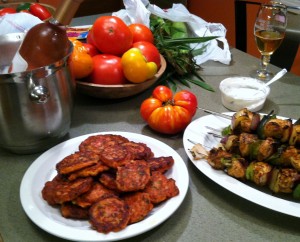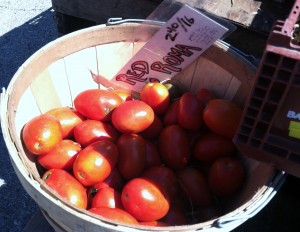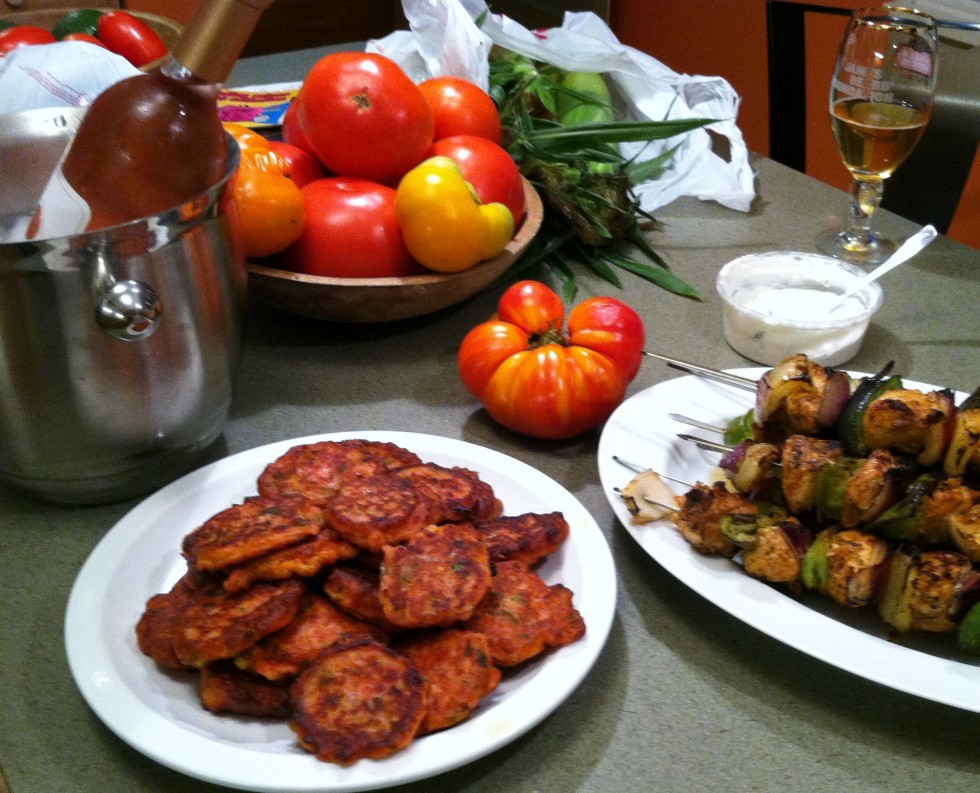Dear Diary,
When we last spoke, on the subject of the divine nature of real summer tomatoes, I promised that I was going to tell you about the two tomato dishes I make that rival the pure joy of eating them straight off the vine. So today I’m going to tell you about Tomato Balls.
I discovered Tomato Balls on the Greek Island of Santorini about 15 years ago, in the tiny town of Akrotiri. This village sits on top of an ancient Minoan town which, 1500 years before the destruction of Pompeii, was also buried and perfectly preserved by a volcanic eruption. Diary, right now I’m not going to go into all the reasons that I happen to be an Ancient Minoan Archaeological Site Groupie, because it isn’t really tomato-relevant, except for the fact that on that particular morning I had spent hours walking through the haunting streets of this ruin and then climbed back up a steep hill to the village in the hot noonday sun, and by the time I got there I was famished and dehydrated. I vividly remember how lovely it felt just to sit down in the shade of a small taverna, whose menu offered ”Tomato Balls”–described on the menu in English only as “Speciality of the Island of Santorini.”

The ones I make should probably be called “Tomato Sliders.”
“Balls” in this case turns out to be one of those rather awkward translations from the Greek “keftedes,” for “meatballs,” since what these are, essentially, is little tomato “meatballs.” We would be more inclined to think of them as fritters or pancakes–very similar to potato pancakes–in other words, a batter made of grated tomatoes mixed with flour, baking powder, and herbs, which is either deep-fried or pan-fried in olive oil. The result is surprisingly very “meaty” in the umami sense of rich, unctuous mouthfeel–but with pure, rich vegetable flavor.
A couple of important points about Tomato Balls: First, you really have to love olive oil, because they soak it up while cooking and that’s what gives them their meaty texture; but in Greek cuisine the olive oil isn’t supposed to serve as cooking grease and then disappear into the dish–it’s part of the flavor profile of the dish. I think if it bothers you instead of delighting you, it just means you’re not using a very good olive  oil. Second, in my experience you can only make Tomato Balls with plum, or Roma, tomatoes. The reason they’re a Santorini speciality is that–Santorini being basically a big volcano–the tomatoes that grow there have a very low moisture content, but very dense and intensely flavored flesh. A few weeks ago I tried making Tomato Balls with regular beefsteak tomatoes (because Romas are coming in very late this year and I simply couldn’t wait any more) and there was just too much juice and not enough flavor to stand up to the flour and the olive oil.
oil. Second, in my experience you can only make Tomato Balls with plum, or Roma, tomatoes. The reason they’re a Santorini speciality is that–Santorini being basically a big volcano–the tomatoes that grow there have a very low moisture content, but very dense and intensely flavored flesh. A few weeks ago I tried making Tomato Balls with regular beefsteak tomatoes (because Romas are coming in very late this year and I simply couldn’t wait any more) and there was just too much juice and not enough flavor to stand up to the flour and the olive oil.
Besides remembering the exact moment I first tasted Tomato Balls and was totally smitten, I also remember the exact moment when, many years later, leafing through a Greek cookbook in a bookstore, I first found a recipe. It was in The Glorious Foods of Greece by Diane Kochilas, whom I regard as the Goddess of Greek Cooking. My copy of the book has long since come apart at the page where this recipe appears, because I can only use it for a few short weeks each year in August and September, and by the time the next year rolls around, I’ve always forgotten the details. The basic recipe I give here is hers, though of course like any home cook I’ve made a few of my own modifications and comments.

